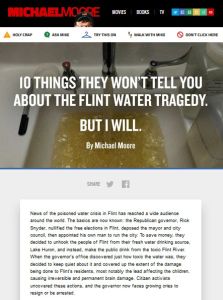Join getAbstract to access the summary!

Join getAbstract to access the summary!
Michael Moore
10 Things They Won't Tell You About the Flint Water Tragedy
But I Will
Michael Moore, 2016
What's inside?
There’s more to the Flint, Michigan, water crisis than you’ve read in the headlines.
Recommendation
In April 2014, Flint, Michigan, became the center of what evolved into a tragic, but entirely avoidable, man-made catastrophe when the town began using highly corrosive water from the Flint River. This change resulted in an unprecedented health crisis, with the town’s population being exposed to high levels of lead. Filmmaker and activist Michael Moore wants you to know 10 important but little-known facts about this unfortunate turn of events. Though Moore’s points are intriguing, they would have made more impact had he provided sources of his information. While always politically neutral, getAbstract recommends this analysis to those wanting insight into the controversy.
Summary
About the Author
Michael Moore is an author and documentary filmmaker. His film Bowling for Columbine won an Academy Award.


















Comment on this summary